- TOP
- History of the Shunko Konwa-kai
History of the Shunko Konwa-kai
Development and History of the Shunko Konwa-kai
| Prewar | 1905 (Meiji 38) | Fusanosuke Kuhara opens Hitachi Mine. in Ibaraki prefecture and Kuhara Mining Co. was founded. |
| 1914 (Taisho 3) | Diversification results in formation of the Kuhara Zaibatsu group (financial group). | |
| 1928 (Showa 3) | Yoshisuke Aikawa becomes president of Kuhara Mining Co. Renamed Nihon Sangyo Corporation (Nissan). | |
| 1934 (Showa 9) | Nissan Mokuyo-kai is established. | |
| 1937 (Showa 12) | Nissan Mokuyo-kai renamed Nissan Konwa-kai Nissan enters Manchuria and is renamed Manchurian Industrial Development Company (Mangyo). | |
| 1945 (Showa 20) | War ends in defeat, zaibatsu are dismantled, Mangyo is dissolved |
| Post war | 1962 (Showa 37) | Group is reformed with the establishment of the Shunko-kai |
| 1966 (Showa 41) | Tokyo Nissan Konwa-kai is established | |
| 1971 (Showa 46) | Renamed Nissan Konwa-kai. Secretariat is established | |
| 2002 (Heisei 14) | Renamed Shunko Konwa-kai, the name that is retained to present |
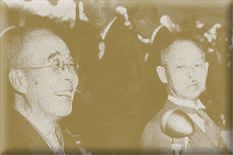 Left: Mr. Kuhara; Right Mr. Aikawa |
The beginnings of the two managers and Nissan From 1905
The roots of the Shunko Group go back to 1905 (Meiji 38). In that year, the founder Fusanosuke Kuhara established Kuhara Mining Co. and started management of Hitachi Mine. Rapid growth followed, leading to diversification of business. He had a hand in the management of numerous companies, such as Hitachi Ltd., Nihon Kisen, Osaka Ironworks, Godo Hiryou, which he developed into a Konzern.
However, with the persistent depression following World War I, he fell into a financial trouble. Then, in 1928 (Showa 3), he gave over the rebuilding of Kuhara Mining to his brother-in-law, Yoshisuke Aikawa , who was from the same prefecture of Japan. Aikawa was able to weather the crisis through capital assistance received from relatives, and at the same time he reorganized Kuhara mining into a holding company and took it public. At that time, taking a holding company public was a revolutionary way of thinking. He went on to change the company name to Nihon Sangyo Corporation, which was commonly called Nissan, thus giving rise to Nissan. While the Shunko-kai was known as Nissan Konwa-kai for many years, the origin of Nissan is here.
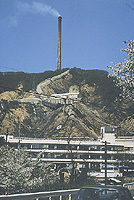 |
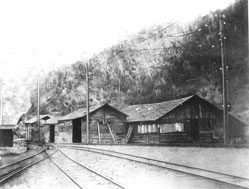 Hitachi Mining Co. Repair Factory The origins of the Hitachi factory (also know as the Sogyo Koya) founded by Namihei Odaira. |
|
| Hitachi Mining smokestack | ||
 |
| Fusanosuke Kuhara |
| Fusanosuke Kuhara | |
| 1869 (Meiji 2) | Born 1869 (Meiji 2) in Yamaguchi prefecture His father was Shozaburo Kuhara, the second oldest brother of Denzaburo Fujita, the founder of the Fujita Gumi. |
| 1889 (Meji 22) | Graduated from Keio University. At first, joined Morimura Gumi, then entered the family business of Fujita Gumi. |
| 1905 (Meiji 38) | Left Fujita Gumi and bought Akazawa Mine in Ibaraki prefecture, renamed it Hitachi Mine, and started Kuhara Mining Co. |
| ・ ・ ・ | ・ ・ ・ |
| 1928 (Showa 3) | Elected to the Japanese House of Representative. Appointed communications minister. |
| 1931 (Showa 6) | Appointed secretary of the Seiyu-kai |
| 1939 (Showa 14) | Appointed president of the Seiyu-kai and Cabinet Councilor. |
| (Banished from holding office after World War II.) | |
| 1951 (Showa 26) | Returned to the political sphere. |
 |
| Yoshisuke Aikawa |
| Yoshisuke Aikawa | |
| 1880 (Meiji 13) | Born to the Yamaguchi prefecture clan. Mother was niece to Kaoru Inoue. |
| 1903 (Meiji 36) | Graduated from the Department of Mechanical Engineering of Tokyo Imperial University. Joined Shibaura Engineering Works Co., Ltd. Later went to the USA to study manufacturing technology for malleable cast iron. |
| 1907 (Meji 40) | Returned from USA. |
| 1910 (Meiji 43) | Founded Tobata Casting Co., Ltd. |
| 1926 (Taisho 15) | Took over business from Fusanosuke Kuhara. |
| ・ ・ ・ | ・ ・ ・ |
| 1952 (Showa 27) | Established Chushokigyou Josei-kai. |
| 1953 (Showa 28) | Elected to House of Councilors. |
| 1956 (Showa 31) | Formed the Political League of Small and Medium-Sized Enterprises and assumed presidency. |
The origin of Shunko Konwa-kai From 1932
From 1932 (Showa 7), Nissan Group growth rocketed. In less than ten years, the Nissan Group came to form a great Konzern with over 150 subsidiaries through acquisition of the major corporations of Nissui, Nippon Oil & Fats Co., Ltd., and Nissan Chemical Industries, Ltd., and by deriving Nissan Motors from Tobata Casting Co., Ltd. (the forerunner of Hitachi Metals), the concern established through the enterprise of Yoshisuke Aikawa.
As the group quickly expanded, organizing and managing it became a major concern. In 1934, (Showa 9), Yoshisuke Aikawa established the informal discussion group Nissan Mokuyo-kai. Executives from each corporation used the Nissan Mokuyo-kai to deepen exchanges. In 1937 (Showa 12), the group was renamed Nissan Konwa-kai and proceeded with more active friendship and information exchange. The origins of the Shunko Konwa-kai's corporate group creation that revolves on cross-linked human relations are to be found here.
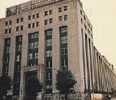 |
| Nissan Kan building (Nissan Konzern main company moves in) |
Nissan Headquarters' entry (move) into and withdrawal from Manchuria From 1937
In 1937 (Showa 12), to execute the 5 year plan for the industrial development of Manchukuo (now northeastern China) at the request of the then Manchukuo government, Yoshisuke Aikawa moved Nissan Headquarters to Manchukuo, changed the name to Manchurian Industrial Development Company (Mangyo), and began working towards realizing the plan.
However, with the reinforcement of the controlled economy brought about by the escalation of the Second Sino-Japanese War came significant changes in the development plan. Yoshisuke Aikawa abandoned development and in 1942 (Showa 17) left Manchuria.
Post-war confusion and the chance to regroup From 1945
Following World War II, the Manchurian Industrial Development Company was broken up upon the directive to disband the zaibatsu. This resulted in a situation in which each of the subsidiary companies was compelled to concentrate on management reconstruction. As the management of each company stabilized, the opportunity for cooperation gradually reappeared, and the regional offices of the companies and affiliates of the former Nissan Group formed a core body for the start of regional Konwa-kai.
In 1962 (Showa 37), at the initiative of Chikara Kurata, the presidents of the thirteen main corporations of the former Nissan Konzern gathered at the Shunko Kaikan building and arranged to hold regular meetings. This was the Shunko-kai, and the Shunko Group was finally reformed.
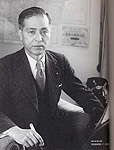 |
| Chikara Kurata |
From the Nissan Konwa-kai to the Shunko Konwa-kai From 1966
Following on this, the Shunko-kai began holding discussions about establishing new group-related organizations that would include affiliated companies. This resulted in 1966 (Showa 41) in the launch of the Tokyo Nissan Konwa-kai comprising 72 corporate members. This was renamed the Nissan Konwa-kai in 1971 (Showa 46). Around this time, activities increasingly ramped up with the successive formation of regional Konwa-kai domestically and overseas, the establishment of the matrimonial agency Family Club, and other functions. In January 2002 (Heisei 14), to strengthen cooperation with Shunko-kai, the ranking organization, Shunko Group was decided on as the corporate group name and Nissan Konwa-kai was renamed Shunko Konwa-kai, launching an era of new expectations.
Now, a century after the founding of Kuhara Mining Co., the Shunko Konwa-kai is forging stronger and deeper links between corporations through regional initiatives.